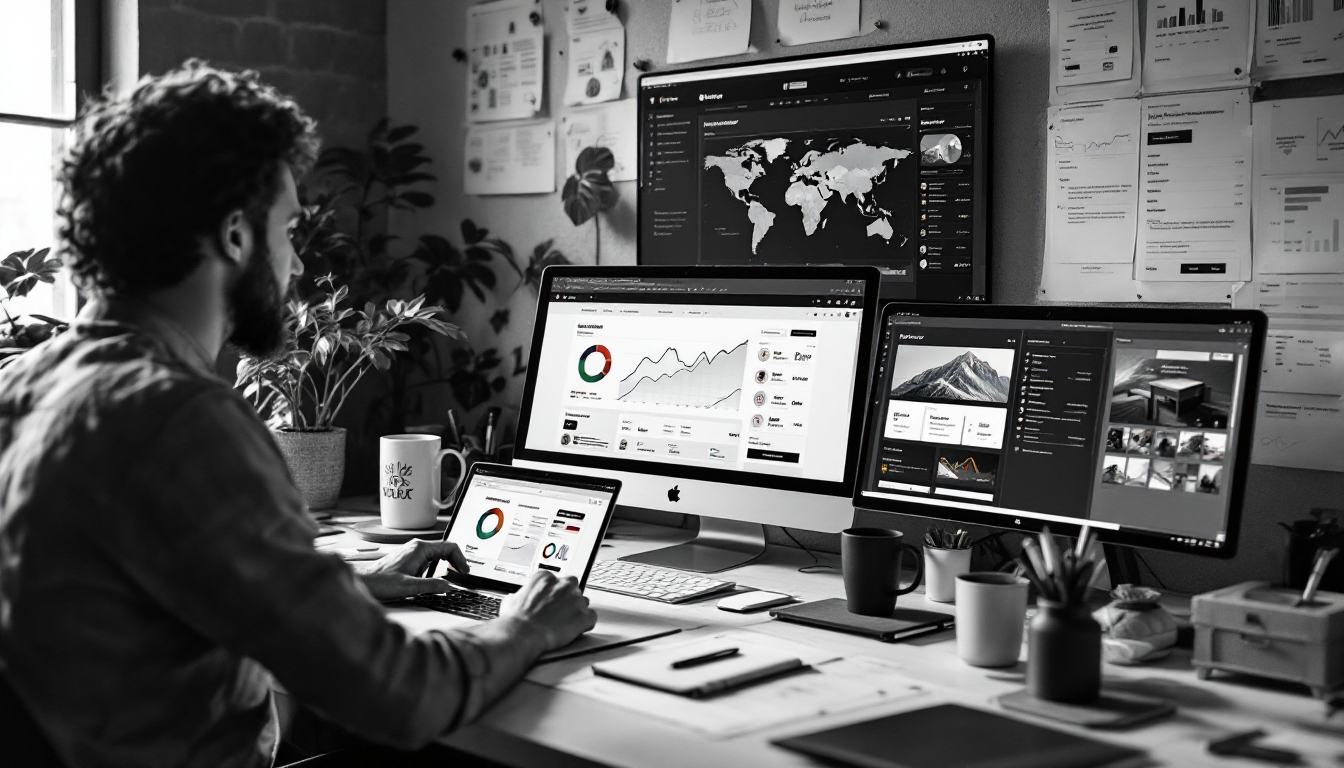What I Learned After Designing 100+ Shopify Stores

When I started building Shopify stores years ago, I thought success was all about visuals — bold images, fancy sliders, and vibrant color palettes. But after designing more than 100 Shopify stores, I realized something far deeper: beautiful design means nothing without conversion-driven strategy.
Every layout, every font choice, every interaction should push one goal forward — turning visitors into buyers.
So in this post, I’m sharing everything I learned after years of hands-on experience designing and optimizing Shopify stores for startups, lifestyle brands, fashion labels, and international eCommerce giants.
Lesson 1: Clarity Always Beats Complexity
In my early projects, I overdesigned. Too many sliders, colors, and fancy effects. But data doesn’t lie — simple stores convert better.
When a visitor lands on your homepage, they should know:
- What you sell
- Why it matters
- What to do next
That’s it.
Every additional visual layer adds friction. So I stripped things down. Clean layouts, responsive design, and clear typography became my mantra.
It’s the same principle I apply when building Next.js projects or personal portfolio websites — clarity first, flair second.
Lesson 2: Mobile Experience Is Everything
80% of all traffic on Shopify now comes from mobile devices. If your site isn’t optimized for thumbs, it’s losing sales.
I design with a mobile-first mindset:
- Simplify menus into collapsible icons.
- Keep CTAs sticky and thumb-friendly.
- Optimize images for smaller screens.
- Use Tailwind CSS grids for responsive layouts.
A flawless mobile experience doesn’t just improve usability — it’s directly tied to conversion rates and SEO visibility.
Just like in Next.js responsive design, consistency across breakpoints builds trust and keeps users engaged longer.
Lesson 3: Storytelling Converts Better Than Discounts
Early on, I focused heavily on price and offers. It worked, but only temporarily. Then I noticed something powerful — brands that told authentic stories converted higher and retained customers longer.
Instead of screaming “20% Off!”, I encouraged clients to share:
- Why they started their brand
- What values they stand for
- The craftsmanship behind their products
When your Shopify store communicates passion, customers buy emotionally and justify logically.
It’s the same as a developer portfolio website — you’re not just listing skills; you’re telling your journey.
Lesson 4: Product Photography Is 50% of Design
I can fix typography, colors, and layouts — but I can’t fix bad photos.
Crisp, consistent, high-quality images make even the simplest theme look luxurious. Use lifestyle shots for emotional pull and white-background images for clarity.
I always suggest a balanced grid layout, similar to Next.js Bento grids, to keep visuals engaging yet clean.
Bonus tip: Use WebP format and lazy-loading for better performance.
Lesson 5: Copywriting Is Design
Design and copywriting are inseparable. A headline can make or break a conversion.
Instead of writing “New Arrivals”, try something like:
“Discover What’s Trending — Handpicked Just for You.”
That emotional touch makes users pause, relate, and click.
Just like Next.js web development tutorials emphasize reusable components, reusable tone and phrasing ensure brand consistency throughout your Shopify store.
Lesson 6: Don’t Fight Shopify — Extend It Smartly
After dozens of projects, I learned not to over-customize. Shopify already does the heavy lifting — cart logic, checkout flow, and analytics.
Instead of hacking the core, I extend it with modern frontend technologies:
- Integrate Next.js storefronts for blazing-fast performance.
- Use Headless CMS setups for flexible content.
- Add Framer Motion animations for seamless micro-interactions.
This modular approach gives the best of both worlds — Shopify’s stability and modern frontend agility.
Lesson 7: Performance Is UX
A fast website feels better. Shopify’s Liquid engine is solid, but speed drops fast when stores are filled with unnecessary scripts or huge images.
Here’s what I do:
- Audit every app before installation.
- Inline critical CSS.
- Defer scripts below the fold.
- Use CDN-hosted media.
Just like server-side rendering in Next.js, fast rendering on Shopify improves SEO and builds trust.
If users have to wait, they bounce — and that’s death for conversions.
Lesson 8: Micro-Interactions Drive Macro Conversions
The best Shopify stores feel alive. I use subtle animations to guide user flow:
- Buttons that react when hovered.
- Product cards that slide in smoothly.
- Cart icons that animate on add-to-cart.
Using Framer Motion principles, these animations aren’t just pretty — they enhance usability and emotion.
They help users feel in control, improving satisfaction and lowering bounce rates.
Lesson 9: Social Proof Is the Silent Salesman
People trust people more than brands. So, every store I build highlights testimonials, reviews, and social mentions front and center.
Even small touches like “Verified Customer” badges make a huge difference.
It’s the same strategy that makes developer portfolio websites credible — showing real results builds authenticity.
Lesson 10: A/B Testing Never Ends
Design isn’t one-and-done — it’s evolution. After every launch, I test variations:
- CTA button colors
- Product page layouts
- Hero section copy
- Pricing structures
Using Shopify’s built-in analytics and heatmaps, I track what actually works.
In many cases, a 1% lift in conversions can double revenue over time. Just like refining Next.js components, small changes compound into massive improvements.
Lesson 11: The Power of Personalization
One-size-fits-all design is dead. Personalization — showing the right product to the right person at the right time — changes everything.
Whether through dynamic banners, location-based offers, or product recommendations, personalization increases engagement significantly.
Shopify APIs make this easy. Combine that with JavaScript frameworks for dynamic rendering, and you have a store that feels tailor-made for each shopper.
Lesson 12: Analytics Turn Guesswork into Growth
Design decisions must be data-driven. I integrate:
- Google Analytics 4 for user behavior
- Hotjar for heatmaps
- Sentry for error monitoring
- Meta Pixel for ad tracking
Together, these tools reveal what’s working — and what’s not. Data-backed design is what separates amateurs from professionals.
Lesson 13: Maintenance Is Design Too
Even after launch, the job isn’t done. Plugins get outdated, new products roll in, and SEO rules evolve.
I schedule quarterly audits:
- Check site speed
- Review conversions
- Refresh product descriptions
- Update theme and apps
A well-maintained site performs consistently — and customers notice.
Lesson 14: Brand Personality Wins Every Time
Every successful Shopify store I’ve built has one thing in common: it knows who it is.
From tone of voice to color palette, personality makes a brand memorable. Your design should reflect your story and values — not chase trends.
I encourage clients to design with purpose, not perfection. That authenticity is what keeps people coming back.
Lesson 15: Simplicity Is the Future
After 100+ stores, one truth stands out — simplicity scales best.
You don’t need a hundred features; you need one perfect funnel. Every successful brand I’ve worked with prioritizes ease of use and seamless customer flow.
If users can get from homepage to checkout in under 3 clicks, you’ve already won.
Final Thoughts: Experience Is the Best Teacher
Designing over a hundred Shopify stores taught me that success lies in balance — between art and analytics, design and data, creativity and clarity.
Shopify gives us a powerful platform, but great designers create experiences, not just pages.
Whether I’m working with Shopify or building Next.js projects, my goal remains the same — to create stunning websites that perform, inspire trust, and drive measurable results.
Because at the end of the day, conversion isn’t just a metric — it’s proof that good design truly works.
